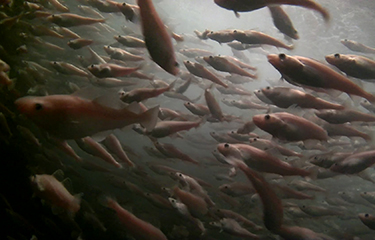Plans for commercial-scale cod farm in the works in Norway

Commercial-scale farming of cod has been tried before, but has never made mainstream success. Trondheim, Norway-based Norcod is hoping to change that.
The company recently announced that it is moving forward with plans to create the first successful commercial-scale cod farm. The company already has its first batch of 260,000 fry in production, and is aiming for the fry to be transferred to the sea in December 2019.
The current target is for the farm to hit an annual capacity of 9,000 metric tons by 2021, increasing to a year-round supply of 25,000 tons by 2025, with “options for further growth” to be assessed “on an ongoing basis.”
“Norcod has licenses in hand for two facilities in Mausund northwest of Trondheim that are being upgraded,” Norcod stated in a release.
Rune Eriksen, the chief executive of Norcod, is well aware of the failures that came before and is planning on using more modern techniques to overcome the issues other operations faced in the past.
Some of those past companies were No Catch, which shuttered in 2007 with GBP 40 million (USD 51.6 million, EUR 46.6 million) in debt. Despite loans from the Norwegian government to help with developing the industry, which consisted of multiple companies back in 2009, none managed to survive.
The issues that kept those companies from succeeding, according to Eriksen, included high mortality, overcrowded nets, mixtures of wild and bred stemfish, and more. Follow-up of the fish and feeding was typical, Eriksen said in a release, leading to waste and escapes. In addition, the economics of how to market and plan a commercial strategy for farmed fish were not as established then as they are now.
“There was a lack of seasonal planning and clearly defined commercial strategies while concessions were bounced around at overinflated prices,” a release from Norcod states. “Norcod spent a lot of time examining what went wrong and what has to be in place to ensure success this time around.”
Norcod is already working to establish a successful market for the product.
“Solid demand and price levels have already been established by professional seafood marketing company Sirena, which will support Norcod's mission by securing sales at the highest prices through its global organization and customer network,” Norcod said. “Sirena trades solely in sustainable product.”
Modern technology, including improved biological material and feed, and more modern farming techniques will help the program surpass the failures of the past.
“The situation is completely different today,” Eriksen said. “Now it's possible. We have the chance to write history as the world supplier of farmed cod.”
Currently, no cod is being farmed industrially, but some companies in Norway are farming the species on a limited scale. Eriksen said he hopes Norcod will be the first to prove it can be done at a high level.
Part of the strategy, according to Eriksen, is applying the knowledge that has been gained in the extensive salmon farming industry in Norway, including the transparency strategies that those companies employ.
“We're taking all the great things developed in salmon farming over the last 10 years; the latest sophisticated technology and equipment,” he said.
That knowledge includes the latest cages designed to prevent escapes and optimize feeding, and understanding the limitations on the number of fish that can be farmed at a time in a net pen at sea.
Globally, the cod industry has been in flux. Certain cod fisheries – like those in New England – have almost completely crashed, with Maine’s catch in 2017 sitting at just under 80,000 pound; substantially lower than the historic high of 21 million pounds.
However, fisheries in other regions, such as Russia and Iceland, have held steady, with the Russian government providing incentives to companies that invest in more modern fleets.
Still, even with successful fisheries, global demand for the product will only continue to rise while wild supplies remain steady, Norcod said.
“Aquaculture's share of worldwide fish supply has been climbing steadily since the turn of the millennium, up from 25.7 percent to 46.8 percent in 2016,” the company wrote. “Farmed fish is forecast to be responsible for over 60 percent of the roughly 150 million tons of fish we will be eating globally by that time. And potentially even more after that, fueled by consumer demand and further possible depletion of wild fish populations (FAO estimates 33 percent of global stocks are today overfished).”
The increased demand, coupled with the more modern techniques, will both contribute to making Nordcod’s new venture a “long-term” project.
“It's a really exciting adventure,” Eriksen said. “And we're absolutely determined to be a global business.”
Photo courtesy of Norcod






Share